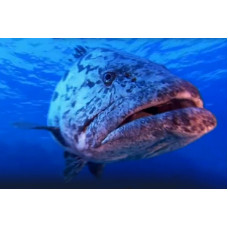Latin name
Epinephelus tukula
Other name
Potato cod or potato bass.
Identification
The potato grouper has a slightly convex area between the eyes and the dorsal profile of the head is straight. The anterior part of the gill cover is rounded or subangular, with slightly enlarged teeth at the corners, while the upper part of the gill cover has a straight edge.
Features of fish fins
The dorsal fin has 11 spines and 14-15 soft rays, and the anal fin has three spines and eight rays. The webs between the spines of the dorsal fin are notched. The caudal fin is rounded.
Fish colouring
This species has a pale brownish-grey colouration with large dark spots separated by broad stripes. Dark lines extend from the eyes and there are small dark spots on the fins. The dark spots on the body are thought to resemble the shape of a potato, giving the species its common name.
Distribution
Widespread in the Indian and Pacific Oceans, but rare in most areas. It is most common along the coast of East Africa from the Red Sea to KwaZulu-Natal in South Africa and around the islands of Madagascar, Seychelles, Mauritius and Reunion in the Indian Ocean. It is then found off the coasts of western India and Sri Lanka eastwards into the Pacific Ocean, where it extends east to the Solomon Islands, north to southern Japan and south to Australia. It has not been recorded in the Persian Gulf. In Australia it is distributed from Shark Bay in Western Australia along the north coast to Morton Bay in Queensland. It is also found on the Great Barrier Reef.
Habitat
They live on coral reefs, in reef channels, and around marine highlands in areas with strong currents. Juveniles prefer shallow water and are often found in tide pools on the reef, while adults inhabit depths from 10 to 150 metres (33 to 492 feet).
Size
Potato grouper has a standard length of 2.9 to 3.5 times its thickness. It is a large and robust species of sea bass, with a maximum published length of 200 centimetres (79 inches) and a weight of 110 kilograms (240 pounds).
Behavior
They are solitary and usually stay within their habitat. They are aggressive and territorial, but their range is relatively small.
Food and feeding habits
They are ambush predators that prey on small rays, crabs, fish, squid, octopus and lobsters. They hide from their prey using coral as cover and when the prey is within reach, they pounce and swallow the prey whole.
Reproduction
They reach maturity at about 12 years of age, when they are 90 to 99 centimetres long and 16 to 18 kilograms (35 to 40 pounds). Groups of smaller fish have been observed, but it is not known if this species aggregates to spawn. Individuals in captivity have been forced to change sex from female to male, so it may be an ancestral hermaphrodite.
Fishing
This species is harvested by local and artisanal fisheries throughout its range, and although it is present in the live fish trade in Hong Kong and China, it is not popular there. It is thought to be vulnerable to overfishing, but this does not appear to be a threat at present. It is protected in South Africa and Australia.
Relationship with a person
A species of fish harmless to humans.
| Classification | |
| Phylum | Chordata |
| Class | Actinopterygii |
| Squad | Perciformes |
| Family | Serranidae |
| Genus | Epinephelus |
| Species | E. tukula |
| Features | |
| Conservation status | Least Concern |
| Habitat | Pelagic |
| Life span, years | No information |
| Maximum body weight, kg | 110 |
| Maximum length, cm | 200 |
| Sailing speed, m/s | No information |
| Threat to people | Edible |
| Way of eating | Predator |
Potato grouper
Tags: potato grouper




